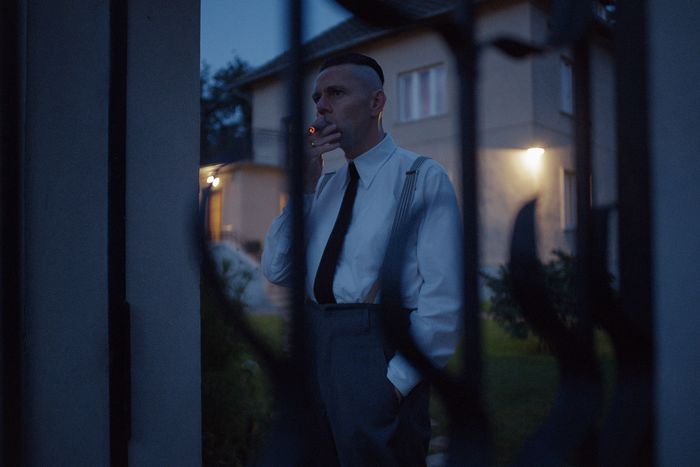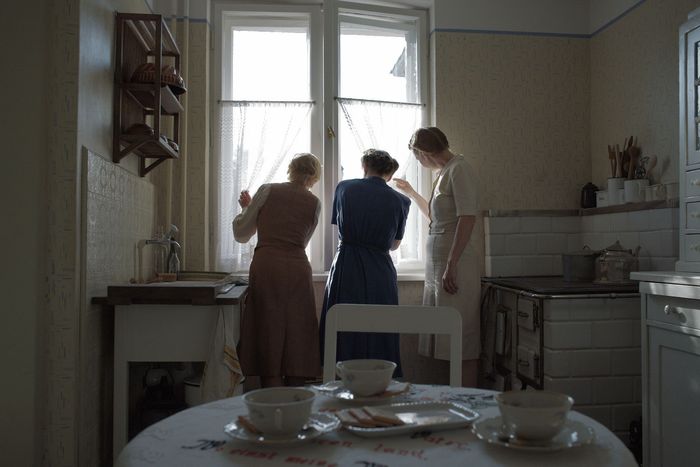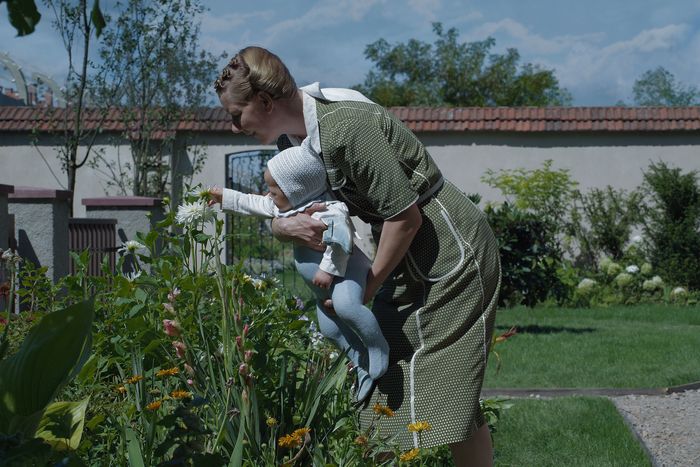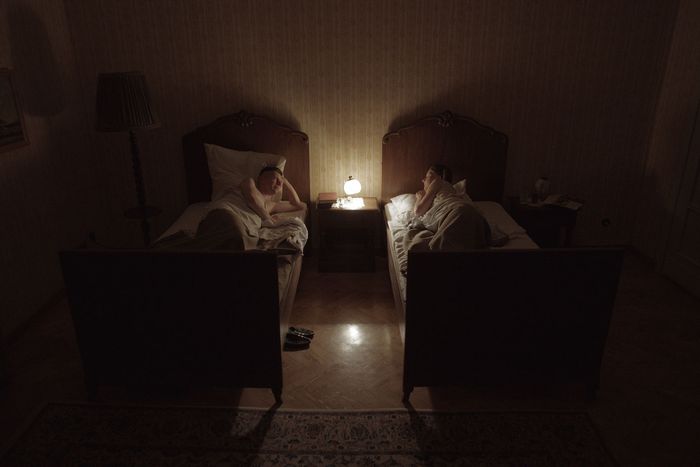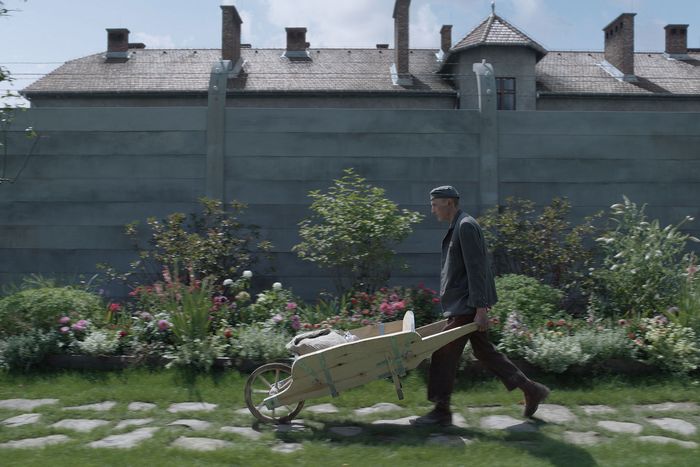Behind the scenes with the designer for The Zone of Interest
The Zone of Interest takes place at the luxurious home of the family of the SS commandant who oversaw Auschwitz and whose garden shared a wall with the camp.
Photo: Courtesy of A24
Jonathan Glazer’s new film The Zone of Interest takes place almost entirely in and around a house. The boxy gray 1937 home is meant to belong to a lightly fictionalized version of the Höss family, whose children play upstairs, whose servants take in deliveries, and whose matriarch delights in the work of her garden. These banal events feel thrilling — terrifying, even — because of what we glimpse on the other side of their garden: Auschwitz, the death camp engineered and overseen by Rudolf Höss, the family patriarch. The deliveries that servants bring inside are the plundered goods of the Jewish prisoners next door. The fires of the crematorium are visible from the children’s bedroom windows.
This proximity is historically accurate; the Höss family lived just outside the gates of Auschwitz. To film, Glazer wanted to plant cameras in a house that was as similar to the Höss family’s real-life home as possible. The original building — known now as the Höss villa — was intact and the owners were willing to rent to the film. But that house was more than 80 years old when production designer Chris Oddy first came on to the project. He knew that using it would have given the film an antique patina, placing the Holocaust safely in the past. Instead, he opted to rebuild the 1937 house from scratch — interiors and exteriors — in a derelict house on the same street, just outside the camp gates.
Curbed spoke to Oddy about designing the film, which won the Grand Prix at Cannes and is shortlisted for an Oscar.
You went into the real Höss-family house. What was it like?
It was built in 1937. Höss took possession of the house in 1940, put another story on the top of it, then remodeled the interior plus the exterior and built the garden. What really struck me when I first visited was this sort of meeting point between the Höss family’s almost Romanesque garden wall and the camp wall. It’s just abutting it, not fixed to it. That shows a kind of consciousness: We’re building this garden around the camp, so we don’t need to build three walls or four walls around it; we can use the camp wall. It seemed like it was all about practicality. That stacks up with other accounts about Höss — that, for instance, when he first started operating crematorium one, he kept a motorbike sidecar on its stand just permanently revving so that you couldn’t hear the screams.
In the film, you can see the guard tower next to the camp entrance through the Höss family’s dining room window. That’s really where it is in relation to the house.
Rudolf Höss, played by Christian Friedel, is shown smoking a cigar in front of the house that Oddy and his team re-created.
Photo: Courtesy of A24
What was it like being inside the real house?
Once you’re in the kitchen, on the ground floor, you can actually look over the wall. So when you’re looking out of the bedroom or the kitchen windows, you’re looking over the camp. Obviously you’re seeing the Auschwitz museum now, but it would’ve been the work camp then. It floors you. It’s astonishing and shocking and kind of unbelievable. And that just seemed like a really important factor to repeat. I was careful to make sure that the physicality of the place and its relationship to the camp really felt the same. It wasn’t an exercise in making a carbon copy; it was an exercise in making sure everything was emotionally correct.
In The Zone of Interest, servants in the home can look out the kitchen window and peer into the death camp next door.
Photo: Courtesy of A24
How’d you find the house you built?
We went all over Poland, all the way down to the Ukrainian border. We went all around the southeast — anywhere that wasn’t too developed, where there wasn’t too much 21st century. We tried to find a house that was close to a river with a similar amount of land around it so that we could re-create the garden and the walls. And we drew a blank. It kind of made us think, No, we’ve got to be in the Zone [of Interest]. We need the same kind of fauna, the same kind of landscape. On a previous visit to the area, we’d stopped off at a house that stood derelict on a plot of land quite close to the real Höss garden. It is a neighbor, 300 or 400 yards down the road. It faces the river in the same orientation. It had been built in the early ’50s and then a family had lived there till the mid-’80s. And since then, it hadn’t been lived in.
From aerial photographs, I could identify where it was in relation to the machinery of the camp. It was very close to the SS sauna building, which is still standing. However, the house was in probate. The brothers who inherited it were at loggerheads over who should get it. Windows had been smashed and the weather had got in and it was in a very bad state. Then COVID hit and funding fell away. We returned to England. I spent a lot of lockdown kind of theorizing what one would need to do to make it a favorable comparison to the real house. Then when we went back to Poland, that probate situation had been sorted out. And so the brother who inherited it was happy for us to rent it and use it.
How long did you work on the house?
It only took four and a half months because there had been two and a half years of planning before that. I built a three-dimensional model on my computer of the garden and the walls and put furniture in it.
Tell me about rebuilding the Höss house.
First, we had to plant trees. They needed to be established but also couldn’t be too mature. So I did that as soon as it was feasible in spring [2021]. [The house’s] overall dimensions were smaller than the real house’s, but its proportions were very similar. We replastered the exterior, put two extra windows in, built both the porches front and back, renovated all the windows, sanded and polished all the floors, redid the stairs, built the rooms into the attic. I was able to build the third floor within that loft area and use the dormer windows, which the original house has. So at every turn, there were sort of moments and opportunities to embrace what was similar and alter what was different. One of the big wins for me was that the real house has herringbone floors, as did this one. So I just had to make sure that they were gleaming new and shiny. It was a pretty intensive four and a half months.
The Höss couple grew up farming and embraced Hitler’s call for Nazis to push eastward and reclaim land. Oddy designed a garden that Hedwig Höss took pride in.
Photo: Courtesy of A24
And everything you built had to actually work, right?
It’s all functioning. We wanted to make sure that the performers didn’t feel like they were on a set. It was imperative that the plants grew and the toilet flushed. It was utterly livable by the time we’d finished.
What was it like being in the Zone?
Evidential things about them and their life kind of just bubble up around you. We were looking at some old period cars and this man came up to us — he clearly wanted to talk. I had my translator with me, and we were chatting with him. It turned out he’d grown up there and, obviously, lived through the war. He said that one day, as a child, he and his friend had been playing somewhere in town with this kind of made-up football — a ball of tape and a string tied up. And along came the Höss child, the oldest one, with a brand-new football. He said, “Yeah, he was dressed like an alien to us. He had incredible clothes, really neat hair, and this brand-new football and he wanted to play with us.”
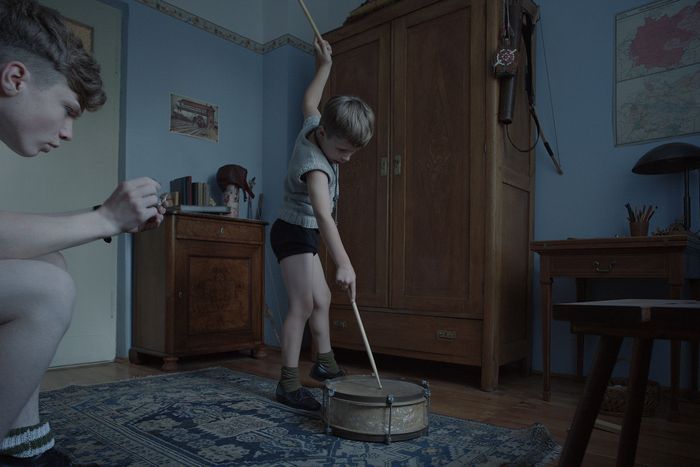
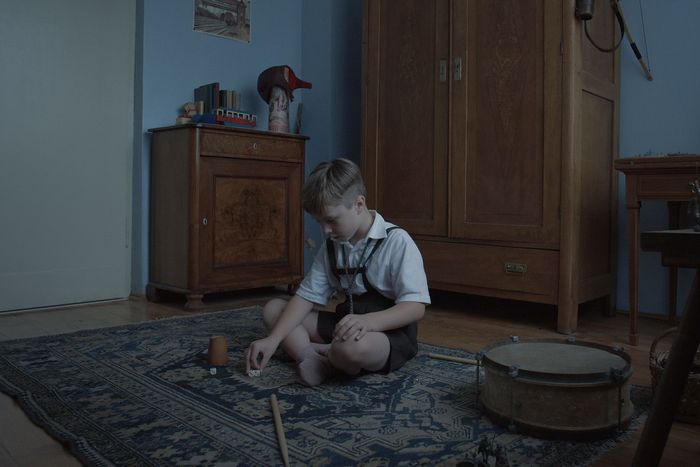
The Höss sons play in an upstairs bedroom, where screams at the death camp next door are audible and a view out the window shows the crematorium. Courtesy of A24.
The Höss sons play in an upstairs bedroom, where screams at the death camp next door are audible and a view out the window shows the crematorium. Cour…
The Höss sons play in an upstairs bedroom, where screams at the death camp next door are audible and a view out the window shows the crematorium. Courtesy of A24.
Wow. Did you meet anyone else who was connected to the Höss family?
The grandson of the person who used to own the house still lives nearby and still has some furniture that the Höss family left behind. We visited him, and he was like, “Yeah, that cupboard was Höss’s, and that chair was Höss’s.” There’s a scene where Höss and three others are sitting in the office talking about a new crematorium being built. The chairs they’re sitting on are original. But as with the house and as with all the other details, it was imperative to just make things new because they were new at the time. We also reviewed written accounts of people who cleaned the houses of SS officers.
The couple’s heavy, dark bedroom set could have been confiscated from any nearby house; when the Nazis invaded Poland, they pushed local families out of their homes.
Photo: Courtesy of A24
What did you learn?
I think it was [an account] from the person who cleaned the house who said that Höss’s desk in the office at his home had a sheet of [clear plastic] Perspex on it. I looked into its invention, and, sure enough, Perspex was made by IG Farben, which also produced Zyklon B. Perspex was a really advanced piece of material, and he just had a piece covering his desk. No doubt that anyone who came into the office at the time would’ve asked, “What is that?” He didn’t need Perspex for any functional reason, but he chose to have it because it was new and because it was an innovation. He’s showing off. So, of course, I put a piece of Perspex on Höss’s desk.
They had their pick of furniture from all these houses that they could pillage from. I was constantly imagining what it would be like to have a daily occurrence of somebody visiting from [the camp warehouse] Kanada, from Birkenau, and coming back with goods — whether that’s a lovely piece of lace or whatever else. The fact that [Höss’s wife, Hedwig] was at liberty to take whatever she wanted? I thought, Well, in due course she might find another tablecloth she likes better and she’ll just get rid of that one. When you’re free to have whatever you want and your aesthetic is form and function before design, things have got to perform their duty; they’ve got to work efficiently. You can’t have excess in the house. It didn’t feel to me like Hedwig would have a relationship with a favorite cushion. It wasn’t in her. I discovered through research at the museum that she personally had prisoners do things for her — like paint the family coat of arms, for example — and then if they made a mistake, they would get gassed for it.
Prisoners made things for them?
There were many things that were made by the prisoners of the camp and used in households of SS families all over Germany but particularly around [the prison town] Oświęcim. Stools were commonly made by the prisoners. I saw original ones, but they were too old — they were too antique. So I made some fresh ones. There’s a stool in the bathroom, and there’s quite a few stools in the garden.
Oddy’s team built a wheelbarrow like the one a camp prisoner might have built. In the film, it’s shown delivering confiscated luxuries to the house.
Photo: Courtesy of A24
Did you work off of photos of the family?
We didn’t have that many pictures to go off of, but the ones I did have I used as forensically as possible. There’s one photo which shows Höss and his children on a bench with a palm in the corner. One of the pictures shows two of the kids playing next to the pool with a big model boat, so I built that boat. And then the two girls are playing with a toy train on the side of that pond.
I noticed, in Höss’s office, a picture of Hitler I’ve never seen before.
I found a few pictures of the interiors of some of the buildings around the camp. One of them was a classroom, and in it, I spotted quite a small picture of Hitler, not standard issue — he wasn’t just presented straight on. And I thought, Wow, that’s interesting. It was necessary to have a picture of Hitler somewhere in your life then. So I quite liked the idea that Höss had a sort of candid view of him. There was something personal about it somehow.
This interview was condensed and edited for clarity. The Zone of Interest is out in theaters now.
Source link

